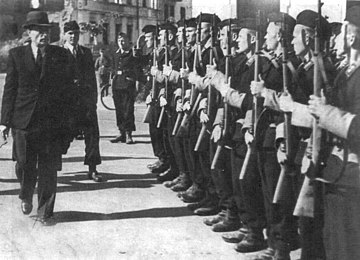Belarusian Auxiliary Police
| Belarusian Auxiliary Police | |
|---|---|

Inspection of Belarusian Auxiliary Police by Radasłaŭ Astroŭski
|
|
| Active | from July 1941 |
| Allegiance | Nazi Germany |
| Role | Auxiliary police |
| Engagements |
Anti-partisan operations The Holocaust in Belarus |
The Belarusian Auxiliary Police (Belarusian: Беларуская дапаможная паліцыя, Biełaruskaja dapamožnaja palicyja; German: Weißruthenische Schutzmannschaften, or Hilfspolizei) was established in July 1941. Staffed by local inhabitants, it had similar functions to those of the German Ordnungspolizei (OrPo) in occupied territories. The activities of the formation were supervised by defense police departments, local commandants' offices, and garrison commandants. The units consisted of one police officer for every 100 rural inhabitants and one police officer for every 300 urban inhabitants. The OD was in charge of guard duty, and included both stationary and mobile posts plus groups of orderlies. It was subordinate to the defense police leadership.
Belarusian Auxiliary Police participated in civilian massacres across villages on the territory of modern-day Belarus; dubbed the anti-partisan actions.
The German police battalions as well as Einsatzgruppen carried out the first wave of killings. The pacification actions were conducted using experienced Belarusian auxiliary guards in roundups (as in Homel, Mozyrz, Kalinkowicze, Korma). The Belarusian police took on a secondary role in the first stage of the killings. The ghettoised Jews were controlled and brutalized before mass executions (as in Dobrusz, Czeczersk, Żytkowicze). After a while the auxiliary police, being locals, not only led the Jews out of the ghettos to places of massacres but also took active part in the shooting actions. Such tactic was successful (without much exertion of force) in places where the destruction of the Jews was carried out in early September, and throughout October and November 1941. In winter 1942, a different tactic was used - the killing raids in Żłobin, Petryków, Streszyn, Czeczersk. The role of the Belarusian police in the killings became particularly noticeable during the second wave of the ghetto liquidation actions, starting in February–March 1942. However, little is known about the specifics of those atrocities committed by the Auxiliary Police in the vast number of small communities both across the territories of Poland annexed by the Soviet Union and in the Soviet Belarus because the Belarusian police involvement in the Holocaust is not acknowledged publicly in the country. Article 28 in the Constitution of the Republic of Belarus, under the "Procedures Governing Access to Documents Containing Information Relating to the Secret Life of Private Citizens" (added in July 1996) denies access to information about Belarusians who served with the Nazis. "The official memorial narrative allows only a pro-Soviet version of the resistance to the German invaders."
...
Wikipedia
